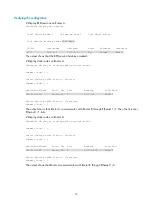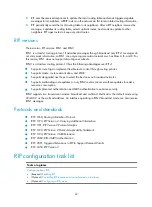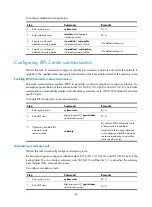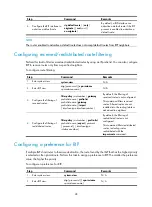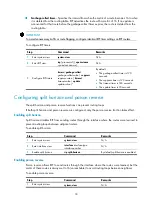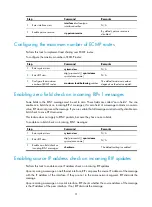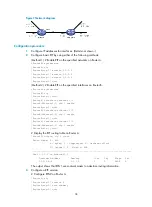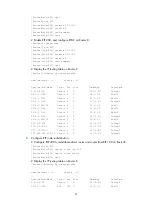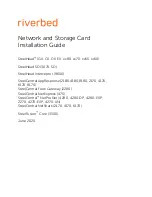
27
Step Command
Remarks
3.
Disable RIPv2 automatic route
summarization.
undo summary
By default, RIPv2 automatic route
summarization is enabled.
4.
Return to system view.
Quit
N/A
5.
Enter interface view.
interface
interface-type
interface-number
N/A
6.
Configure a summary route.
rip summary-address
ip-address
{
mask
|
mask-length
}
By default, no summary route is
configured.
Disabling host route reception
Perform this task to disable RIPv2 from receiving host routes from the same network to save network
resources. This feature does not apply to RIPv1.
To disable RIP from receiving host routes:
Step Command
Remarks
1.
Enter system view.
system-view
N/A
2.
Enter RIP view.
rip
[
process-id
] [
vpn-instance
vpn-instance-name
]
N/A
3.
Disable RIP from receiving
host routes.
undo host-route
By default, RIP receives host routes.
Advertising a default route
You can advertise a default route on all RIP interfaces in RIP view or on a specific RIP interface in interface
view. The interface view setting takes precedence over the RIP view settings.
To disable an interface from advertising a default route, use the
rip default-route no-originate
command
on the interface.
To configure RIP to advertise a default route:
Step Command
Remarks
1.
Enter system view.
system-view
N/A
2.
Enter RIP view.
rip
[
process-id
] [
vpn-instance
vpn-instance-name
]
N/A
3.
Enable RIP to advertise a
default route.
default-route
{
only
|
originate
}
[
cost
cost
]
By default, RIP does not advertise a
default route.
4.
Return to system view.
quit
N/A
5.
Enter interface view.
interface
interface-type
interface-number
N/A



